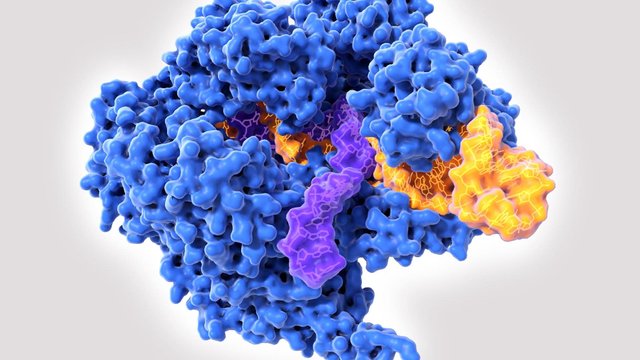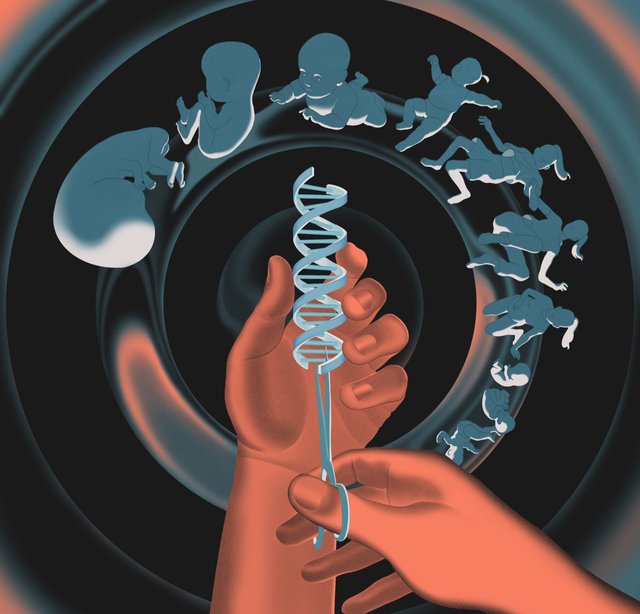It is now possible to insert an entire gene using CRISPR therapies/Ya es posible insertar un gen entero utilizando las terapias CRISPR
.jpg)
Source
As you all know, CRISPR (Clustered Regularly Interspaced Short Palindromic Repeats) is a gene-editing tool that can be used to modify DNA precisely and easily. The origin of this technology lies in a natural defense system that bacteria use to protect themselves from viruses. When a bacterium survives a viral infection, it stores a fragment of the attacking virus's DNA in special sequences of its own genome called CRISPR, which function as a kind of "immune system" that protects the bacteria.
Como todos sabéis, CRISPR (Clustered Regularly Interspaced Short Palindromic Repeats) es una herramienta de edición genética con la que se puede modificar el ADN de manera precisa y sencilla. El origen de esta tecnología está en un sistema natural de defensa que usan las bacterias para protegerse de los virus, cuando una bacteria sobrevive a una infección viral, guarda un fragmento del ADN del virus que la atacó en unas secuencias especiales de su propio genoma llamadas CRISPR, que funcionan como una especie de “sistema inmunológico” que protege a las bacterias.
Biologists have learned to use this system outside of bacteria, and now CRISPR/Cas9 is used as a tool to “cut and paste” DNA in almost any organism, much like a text editor. First, a guide molecule (guide RNA) is designed to carry the Cas9 protein to the exact location of the DNA to be modified. Cas9 acts like “molecular scissors” that cut the DNA at that specific point, and genetic information can then be removed, corrected, or inserted at that site, taking advantage of the cell’s natural DNA repair mechanisms.
Los biólogos han aprendido a utilizar este sistema fuera de las bacterias y ahora, CRISPR/Cas9 se usa como una herramienta para “cortar y pegar” el ADN en casi cualquier organismo como si fuese un editor de textos. Primero se diseña una molécula guía (ARN guía) que lleva a la proteína Cas9 al lugar exacto del ADN que se quiere modificar. Cas9 actúa como unas “tijeras moleculares” que cortan el ADN en ese punto específico, y después se puede eliminar, corregir o insertar información genética en ese sitio, aprovechando los mecanismos naturales de reparación del ADN de la célula.

Source
Until now, traditional CRISPR systems (such as Cas9) allow for point edits or small insertions/deletions of up to approximately 20 base pairs, but new variants have recently been discovered, such as prime editing and its evolution twin prime editing (twinPE), which have managed to radically expand this capacity to work on entire genes that can be between one thousand and ten thousand base pairs long.
Hasta ahora, los sistemas CRISPR tradicionales (como Cas9) permiten ediciones puntuales o pequeñas inserciones/eliminaciones de hasta aproximadamente 20 pares de bases, pero recientemente se han descubierto nuevas variantes, como el prime editing y su evolución twin prime editing (twinPE), que han conseguido ampliar radicalmente esta capacidad hasta lograr trabajar sobre genes enteros que pueden tener entre mil y diez mil pares de bases.
The Twin Prime Editing (twinPE) technique, developed by the Broad Institute, makes two adjacent DNA edits to create "spaces" for inserting long sequences (up to thousands of base pairs). Unlike previous techniques, it avoids double-strand breaks, reducing errors and unwanted chromosomal alterations. It uses custom guide RNAs and modified Cas enzymes to improve specificity, and combines guide RNA libraries and cell selection systems to validate insertions.
La técnica Twin Prime Editing (twinPE) ha sido desarrollada por el Broad Institute, este método realiza dos ediciones adyacentes en el ADN para crear "espacios" donde insertar secuencias largas (hasta miles de pares de bases). A diferencia de técnicas anteriores, evita cortes de doble cadena, reduciendo errores y alteraciones cromosómicas no deseadas. Utiliza ARN guía personalizados y enzimas Cas modificadas para mejorar la especificidad además de combinar bibliotecas de ARN guía y sistemas de selección celular para validar las inserciones.

Source
The therapeutic applications of this technology could be astonishing, as they allow for the replacement of mutated genes in genetic diseases, such as cystic fibrosis, as well as the insertion of therapeutic genes to compensate for altered functions in immunodeficiencies. Although still in the experimental phase, these advances represent a qualitative leap toward safer and more effective gene therapies, with clinical trials underway to validate their potential.
Las aplicaciones terapéuticas de esta tecnología puede ser asombrosas ya que permiten reemplazar genes mutados en enfermedades genéticas, como por ejemplo la fibrosis quística, así como insertar genes terapéuticos para compensar funciones alteradas en inmunodeficiencias. Aunque aún en fase experimental, estos avances representan un salto cualitativo hacia terapias génicas más seguras y eficaces, con ensayos clínicos en desarrollo para validar su potencial.
But it's still early days; widespread access to CRISPR-based therapies still faces several challenges, and it will likely take several more years for them to become available to the majority of the population. Currently, there is only one approved CRISPR therapy for very specific diseases like sickle cell anemia and beta-thalassemia, and its price tag is around $2 million per patient. But it's all a matter of continued research, and there's no doubt that in the not-too-distant future, we'll all be able to benefit from it.
Pero aún es pronto, el acceso generalizado a terapias basadas en CRISPR aún enfrenta varios desafíos y probablemente tomará varios años más para que estén disponibles para la mayoría de la población. Actualmente, solo existe una terapia CRISPR aprobada para enfermedades muy específicas como la anemia falciforme y la beta talasemia, y su precio ronda los 2 millones de dólares por paciente. Pero todo es cuestión de seguir investigando y no cabe duda que en un futuro no muy lejano todos podremos beneficiarnos de ello.
More information/Más información
https://www.chop.edu/news/worlds-first-patient-treated-personalized-crispr-gene-editing-therapy-childrens-hospital
https://es.wired.com/articulos/crispr-ya-es-posible-insertar-un-gen-entero